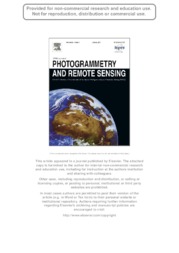Mapping impervious surfaces with the integrated use of Landsat Thematic Mapper and radar data: a case study in an urban-rural landscape in the Brazilian Amazon.
Mapping impervious surfaces with the integrated use of Landsat Thematic Mapper and radar data: a case study in an urban-rural landscape in the Brazilian Amazon.
Autoria: LU, D.; LI, G.; BATISTELLA, M.; FREITAS, C. C.
Resumo: This research explored the integrated use of Landsat Thematic Mapper (TM) and radar (i.e., ALOS PALSAR L-band and RADARSAT-2 C-band) data for mapping impervious surface distribution to examine the roles of radar data with different spatial resolutions and wavelengths. The wavelet-merging technique was used to merge TM and radar data to generate a new dataset. A constrained least-squares solution was used to unmix TM multispectral data and multisensor fusion images to four fraction images (high-albedo, low-albedo, vegetation, and soil). The impervious surface image was then extracted from the high-albedo and low-albedo fraction images. QuickBird imagery was used to develop an impervious surface image for use as reference data to evaluate the results from TM and fusion images. This research indicated that increasing spatial resolution by multisensor fusion improved spatial patterns of impervious surface distribution, but cannot significantly improve the statistical area accuracy. This research also indicated that the fusion image with 10-m spatial resolution was suitable for mapping impervious surface spatial distribution, but TM multispectral image with 30 m was too coarse in a complex urban?rural landscape. On the other hand, this research showed that no significant difference in improving impervious surface mapping performance by using either PALSAR L-band or RADARSAT C-band data with the same spatial resolution when they were used for multi-sensor fusion with the wavelet-based method.
Ano de publicação: 2011
Tipo de publicação: Artigo de periódico
Unidade: Embrapa Territorial
Observações
1 - Por padrão são exibidas publicações dos últimos 20 anos. Para encontrar publicações mais antigas, configure o filtro ano de publicação, colocando o ano a partir do qual você deseja encontrar publicações. O filtro está na coluna da esquerda na busca acima.
2 - Para ler algumas publicações da Embrapa (apenas as que estão em formato ePub), é necessário ter, no celular ou computador, um desses softwares gratuitos. Sistemas Android: Google Play Livros; IOS: iBooks; Windows e Linux: software Calibre.
Acesse outras publicações
Acesse a Base de Dados da Pesquisa Agropecuária (BDPA) para consultar o acervo completo das bibliotecas da Embrapa.

